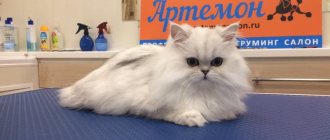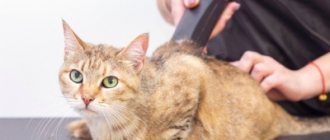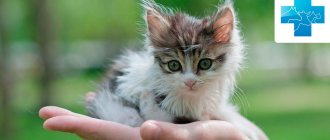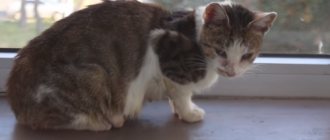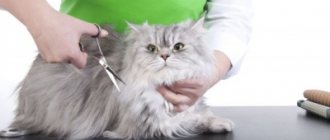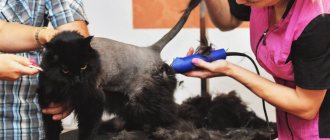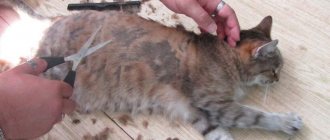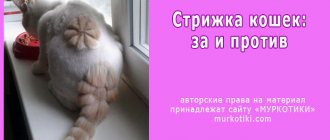Hygienic, high-quality care for pets is called grooming.
The complex of care measures includes combing out excess undercoat, haircut (sometimes shaving), bathing, cleaning the ears and plaque from the teeth, trimming and sealing the tips of the claws. Compared to dogs, cats require less maintenance to keep them hygienically clean. Many veterinarians believe that cats do not need partial or complete hair trimming, since such a procedure can cause more harm than good. And they recommend cutting your pet’s hair only when necessary.
Why shouldn't you cut cats?
Cats do not need a haircut: their fur creates a protective function, regulating body temperature and saving the paw pads from various injuries. These animals “wash themselves” by licking themselves and their relatives; combing itself with claws, thereby preventing the formation of tangles.
If the owner believes that his pet is suffering from the summer heat, then there is no need to rush into cutting it. It is enough to provide the cat with a cool place, for example in the bathroom, under an air conditioner, and you should also make sure that there are several bowls of water in the house.
Reasons why it is not advisable to cut your cat's hair
The opinions of veterinarians vary, but on some points they are unanimous:
The process of shearing is a strong shock and stress for the animal. As a result, a decrease in the body's immune defense may occur.- Due to frequent haircuts, the coat becomes thinner, which contributes to the formation of tangles more frequently.
- Constant haircuts can change the color, structure of the coat and undercoat. It becomes dull and brittle.
- The cat's skin becomes drier, often causes itching and leads to scratching, which will then have to be treated for a long time.
Veterinarians strongly do not recommend cutting cats with short-haired breeds or those with medium-length hair:
- Burmese,
- Maine Coon,
- Norwegian forest cats,
- redgolls,
- Siberian cats,
- Turkish Angoras.
Their fur has a special structure and differs significantly from other species: it consists of two layers and has different hair lengths. A hairless cat can easily become overheated or hypothermic.
Tools and accessories
Even knowing that there are special salons, many people wonder how to cut a cat’s hair at home. In fact, without skill, it is better not to undertake the implementation of complex decorative designs and limit yourself to hygienic forms with minimal intervention. Otherwise, trying to trim a cat’s hair at home will result in serious injuries for all participants in the process.
Grooming cats in grooming salons is not complete without a cat clipper. They come in different capacities. For long-haired pets, as well as cats with thick undercoat, trimmers with a power of 45 watts or more are recommended. Other breeds can be trimmed with a less powerful clipper. Recommended wool length is 3 mm. Knife No. 3 is suitable for this. A regular trimmer is used in conjunction with a clipper to trim hard-to-reach areas.
You should not use a mechanical clipper to cut human hair. Despite the lack of noise and accessibility, you are unlikely to achieve symmetry and correct lines.
A must-have accessory is scissors. Preferably with rounded ends. To correct a cat's hairstyle at home, it is enough to buy regular ones, but in salons they also use thinning ones. They smooth out possible defects and provide the hairstyle with a finished look.
Before cutting, the fur must be thoroughly combed, so you can’t do without a brush; in addition, you will need it after cutting.
Stock up on hydrogen peroxide and cotton swabs, they will come in handy if something goes wrong.
When is a cat's haircut necessary?
There are situations when a four-legged friend really needs to cut his fur coat. Let's look at the main ones:
When a cat has a large number of mats of different sizes. Combing the animal in such cases may not always give results, since the tangles very quickly form dense wool balls, which are easier to cut out. In addition to being unsightly, tangles cause discomfort and health problems for your pet. By tightening the skin, they interfere with blood flow and cause itching. After all, by their nature, cats are very clean; they will try to get rid of the formed tangles on their own, scratching and gnawing out the lumps. But this is dangerous for the pet - he may accidentally swallow a hairball, which can block the passage in the digestive tract or cause severe vomiting.- Skin disease. It can be recognized by the appearance of weeping ulcers on the skin. The thick coat will make it difficult to treat with medications and will not provide adequate ventilation.
- Long molting. It can be caused by various reasons from skin problems to metabolic disorders. It is worth consulting a doctor in a timely manner.
- One of the family members has a wool allergy. But this method of getting rid of wool in the house is ineffective. After cutting, the amount of hair will decrease in volume, but if a person has an acute allergic reaction to wool, then the number of hairs on the pet’s body does not matter. We will have to look for other ways to combat allergies.
There are some cats that physically cannot take care of themselves. This is mainly due to age. Their fur will look dirty and unkempt, so it's best to keep it trimmed.
Types of haircuts for cats
A special hygienic haircut is carried out no more than twice a year, so as not to damage the structure of the coat and skin. If the cat must participate in an exhibition, the last haircut is done no later than six months before the event.
Trimming is usually done with a special clipper, leaving a hair length of approximately 3-3.5 millimeters. After this procedure, the animal’s skin becomes soft and velvety to the touch.
It is not advisable to cut your cat’s hair on your own, since a high-quality result will require many special tools:
- different types of hairdressing scissors,
- hair clipper,
- set of combs
It is forbidden to cut cats completely, that is, bald. This will disrupt the heat exchange process and can soon cause serious skin irritation.
Therefore, when grooming an animal, it is necessary to leave at least a minimum length of hair to protect it from sunburn or hypothermia.
Description and photo
Sometimes, for stylish reasons, show cats are given a model look by experimenting with types of trimming. There are many options for such haircuts now, but let’s look at the most popular ones:
- "Puma" - short hair on the body, and the head looks like a lion's mane;
- “Dragon” is a curly haircut in which hairs are left along the line of the spine, and various figures or symbols are cut from them;
- “Golfies” - hair is removed only on the upper part of the paws.
How to prepare for a haircut
Before starting the procedure, choose a place for it - a spacious, flat surface. It is best to use a kitchen table. Remove all unnecessary items from it.
Enlist the help of an assistant. It is difficult to carry out the procedure alone, since it is quite lengthy. Stock up on treats for your pet.
Prepare the necessary tools:
- Trimmer for hard-to-reach and intimate areas.
- Scissors with blunt ends or a tangle cutter.
- Thinning scissors.
- A clipper (if the cat has long hair, you need a powerful electric clipper, at least 45 W).
I also recommend preparing the following materials:
- a thick towel to wipe the cat;
- a disposable diaper in case of an unexpected bowel movement;
- gloves for yourself and your assistant;
- thin comb and brush for combing;
- softening conditioner for combing;
- lubricant for the machine.
How to trim or shave a pet?
There is nothing complicated in grooming a cat if you follow the rules and sequence of actions:
- Nail trimming. The claws are trimmed with special tweezers, having been disinfected in advance. When you lightly press the paw pads, the hidden claws will extend. The owner will need to trim only the very ends.
- To begin with, you may need an assistant - he will hold the animal, preventing it from running away. Some cats react aggressively to the appearance of grooming tools. For the safety of the owner and the pet itself, it is worth putting a special plastic collar on the animal that does not allow it to bite.
The cat is laid on its side, its paws are fixed. To cut, you need a machine or scissors. The machine will help avoid damage to the skin, but can be frightening with its buzzing.- First, the hair is removed from the sides, and then moved to the back and belly. You need to remove hair as it grows, and in the opposite direction. Hair that remains long after cutting with a clipper can be trimmed with nail scissors. There must be a tassel on the tail.
- At the end of the procedure, the pet must be bathed with a special shampoo for cats, and then dried with a towel. If your pet is not afraid of a hair dryer, it can also be used for drying. But veterinarians still recommend going to a professional groomer. Because he is a competent and qualified specialist. He will do the haircut quickly and without any damage.
When performing a haircut of any shape, there are certain rules:
- in order not to damage the mustache and hair in the ears, the hair on the head, muzzle and in the auricle is not cut;
- “socks” are left on the lower part of the legs;
- the hairs of the front legs under the elbow and from the hind legs under the jumping joint are not removed;
- the hair is left at the end of the tail (a section at least 3 cm long must be left uncut).
Important rules to know
Before starting the procedure, read the rules for its implementation.
- The paws, tail and head are never cut to zero. There are receptors there that allow the pet to navigate in space.
- The longer the machine runs, the hotter it gets. The cat may get burned.
- Do approaches for 10-15 minutes and take breaks, giving your pet time to rest.
- Leave at least 3 mm of fur on the skin, and preferably 1-2 cm.
- Do not press the blade close to the animal's body, as this may injure it.
- Be sure to lubricate the blade so it glides through the fur rather than tearing it.
- 2-3 days before the procedure, bathe your pet (read how to wash a cat in a separate article). However, if there are mats on your body that cannot be removed, postpone bathing.
Benefits and harms
Like any grooming procedure, cat trimming has its positive and negative properties. Let's look at them in detail.
Pros:
Relief from heat and health problems. There is a very common stereotype that representatives of long-haired breeds suffer from heat, especially during the hot season.- It is necessary to cut a cat if for some reason (for example, due to age) it cannot care for its fur, and you do not have the opportunity to constantly care for it. All this can soon lead to a visit to the veterinarian, and in worst cases, to surgery.
- Caring for a cat can also save the lives of owners who suffer from allergies or asthma. It will help eliminate the factor leading to suffocation and exacerbation of the disease.
Minuses:
- Many cats have a negative attitude towards haircuts. It, like bathing, causes discomfort and stress for the cat. After this, the pet may be depressed, and due to resentment, it may even become offended and ignore the owner. Particularly proud pets can leave a “surprise” in their owner’s slippers in retaliation for an attack on their fur coat.
- After cutting, the cats' hairs become a little smaller. Even the color of the animal may become lighter. If the coat is shortened too much, the animal will feel unwell and may experience dryness and loss of elasticity.
- There are cases when in some areas of the skin the hair does not grow back after cutting. This means that alopecia appears. This is caused by hypothermia and improper hair growth. This condition is mainly characteristic of dogs, but there have been cases when it also occurred in cats. If baldness began to appear even before the cut, do not try to solve the problem: here you need to contact a veterinarian.
What to do after a haircut
After the procedure, calm the animal down and give it a treat. You need to wipe the cat with a towel and comb it. If possible, bathe the animal and dry it properly. Be prepared for the fact that after the procedure the hair may change structure.
The pet's behavior may also change: a vengeful animal may take a shit, a timid animal may hide in dark places. If a cat is hiding in a warm place, it means she is cold. Help get through the fur growth period by dressing your cat in warm clothes and keeping his resting area warm. For the next cut, take note that the previous length brings discomfort to the cat.
